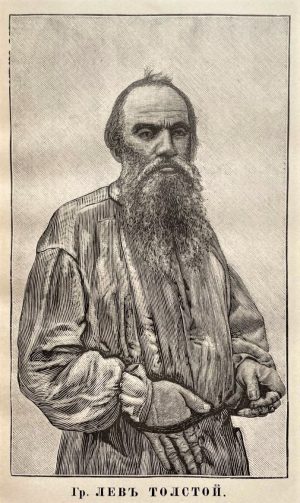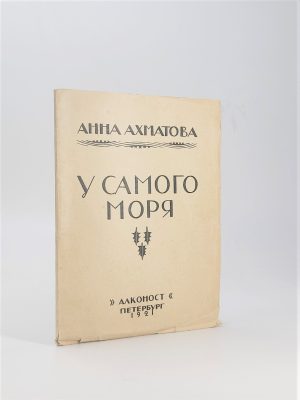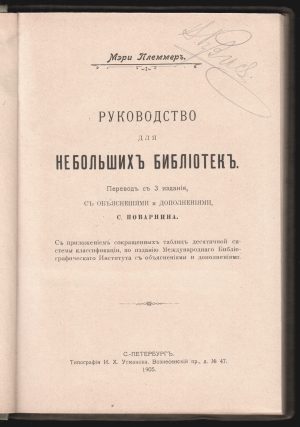Our Notes & References
Lovely Sammelband of works by and about Tolstoy, most in first Russian editions, including one illustrated by Nadezhda Zhivago. The first pamphlet was forbidden in Russia, like many editions of ‘Nikolai Palkin’, an anti-militarist novella about punishments and torture in the army under Nicholas I and Alexander II. The story is based on the eye-witnessing account of a 95-year-old soldier, whom Tolstoy met in 1886.
The work remained banned in tsarist Russian even after the censorship was lifted in 1905, and it came out in Petrograd only in 1917.
‘Nikolai Palkin’ is here published together with ‘Emilian the Worker’ and ‘Too Dear!’, two variations of Tolstoy on previous texts: the first, written in 1886, is a take on the folk take ‘An Empty Drum’ published by Sadovnikov in 1884; the second is a rendition of Maupassant’s “Sur l’eau” (1888).
Both ‘Nikolai Palkin’ and ‘Emilian the Worker’ were published first outside Russia, by Elpidine in Geneva, both in 1891. Sophia Tolstoy tried to include ‘Emilian’ in Tolstoy’s collected works in 1892, but the censors cut it out from the proofs. Eventually, it came out in Russia in a censored form in a 1892 collection published as part of famine relief. Then it came out in this, uncensored, edition by Chertkov; it appeared in Russia as uncensored in 1906, published by Posrednik.
‘Too Dearl’, a satire on capital punishment, appears here for very first time, with Chertkov’s slight deviations from Tolstoy’s manuscript. In Russia it was published for the first time, in this version, in 1901, by Kliukin (“Dorogo stoit” i drugiie rasskazy), and then, with even more deviations, in the 12th Collected Works in 1911 (see Notes to Vol. 27 of Tolstoy’s Collected Works in 90 volumes, Moskva, 1936, p.680).
The volume includes also the first edition in the original Russian of two tales by Tolstoy, ‘The Assyrian King Assarkhadon’ and ‘Three questions’, both written in 1903. The first text was inspired by an anonymous tale ‘Das bist du’, published in the German periodical ‘Theosophischer Wegweiser’ (1903, №5).
Tolstoy started writing ‘The Three Questions’ in competition with Leskov in 1887. The main idea was to write a parable about the three following questions: which time is the best for doing things, which people are the best to spend time with, and what activity is the best to do. Tolstoy’s first variant of the story, titled ‘Mudraia devitsa’ [‘The Wise Girl’], appeared in his collection ‘Tsvetnik’ (Kiev, 1888). This new version however was finished much later, on 9 August 1903. On 20 August Tolstoy sent ‘The Assyrian King Assarkhadon’ and ‘Three questions’ to Sholem Aleichem for publication, in a Yiddish translation, in the collection ‘Gilph’ (Warsaw, 1903), in aid of victims of Kishinev pogroms.
Tolstoy’s publishing company, Posrednik’, produced the original Russian slightly later, to allow time for the charity edition. A the third tale, ‘Trud, smert i bolesn’ [‘Labour, Death and Illness’] was banned by the Russian censors.
This edition is attractively illustrated by Nadezhda Ivanovna Zhivago (1875-after 1930), an artist, translator, and children’s author. An aristocrat by birth, she studied under Leonid Pasternak and worked for the publisher Sytin. She emigrated after the revolution, and from 1923 lived in the USA, working as a translator at the International Institute in Los Angeles. The fact that she is the namesake of the protagonist of ‘Doktor Zhivago’ is a coincidence: in a conversation with Varlam Shalamov, Leonid’s son Boris Pasternak said that he chose the name as it was popular in Siberia, and also because the word “zhivago” in a Russian Orthodox prayer means “living [God]” (Shalamov V. Sobraniie sochinenii. V. 4. Moskva, 2005).
Both pamphlets by Tolstoy are separated in this volume by the first edition in Russian of Anna Seuron’s account of her life as a governess of Tolstoy’s daughters. This is a translation by S. Sergiievskii of the original German, published the same year in Berlin by S. Cronbach.
Provenance
Sir Isaac Shoenberg (1880-1963, a British electronic engineer of Belarus descent best known for his contribution to the development of the first fully electronic television system); by descent, the scholar Peter Gatrell and his wife Jane; acquired directly from their estate.
Bibliography
Svod. Kat. russk. nelegalnoi i zapreshchennoi pechati XIX veka 2045 for the first publication.
Physical Description
Six works in three publications, bound together in one volume 8vo (20 x 14 cm; Palkin smaller: block 18.5 x 11.5 cm). Palkin: 29 pp. inc. title, [3] pp. publisher’s announcements and catalogue; Shest let: half-title, title, frontispiece with portrait of Tolstoy, 106, [2] pp. t.o.c.; Assarkhadon: 30 inc. title and leaf with ill., [1] p. ill., with 7 full-page illustrations in text by Zhivago.
Binding
Later straight-grained brown morocco spine over burgundy cloth, spine with raised bands without lettering, third work with printed lower wrapper bound in.
Condition
Spine very lightly sunned; except a couple of marginal spots to a few leaves of second work, very clean and fresh, third work with light trace of horizontal fold.

















![Image for RUMOVSKII (ed.), Mesiatsoslov na...1782 [Almanac for...1782], St. Petersburg, 1781. In wrappers. #3](https://www.pyrarebooks.com/wp-content/uploads/2023/01/1722_2-300x461.jpg)


